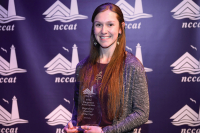Cherokee musical focuses on life of Will Holland Thomas
 About 30 people sat scattered around the 2,800-seat Mountainside Theater in Cherokee, watching the makings of something that has never graced the stage there before.
About 30 people sat scattered around the 2,800-seat Mountainside Theater in Cherokee, watching the makings of something that has never graced the stage there before.
After debuting its first new play in more than 60 years last year, the Cherokee Historical Association will take another giant leap by premiering the theater’s first historical musical, “Chief Little Will,” in 2014.
New outdoor drama debuts at Cherokee’s Mountainside Theater
 For the first time in its 62-year history, the Mountainside Theater in Cherokee has added a new play to its repertoire.
For the first time in its 62-year history, the Mountainside Theater in Cherokee has added a new play to its repertoire.
At long last, Cherokee telling their own story
For decades the story of the Eastern Band of Cherokee Indians wasn’t their own.
Tourists flocked to see Cherokee men dance in the streets dressed as Great Plains Indians, arrayed in long feathered headdresses. The tribe’s history play, “Unto These Hills,” which was supposed to tell the story of the Cherokee nation, was written and acted by whites and riddled with historical inaccuracies.
Meanwhile the Museum of the Cherokee Indian, built in 1976 as the repository of the tribe’s recorded history, didn’t have an exhibit that could communicate an impression of the Eastern Band as a people.
“There were artifacts everywhere, but you wouldn’t know anything more about the Cherokee when you left than when you’d come in,” said Ken Blankenship, the museum’s longtime director.
This weekend, when the Cherokee Voices Festival arrives on the museum’s doorstep, that will all have changed.
The Museum of the Cherokee Indian will have opened its brand new $2 million Resource and Education Building, a project that will share its archives with the tribe’s members and signal the culmination of a decade of effort to recraft the tribe’s historical narrative. That work began with the 1998 update of the museum’s permanent exhibition, which turned the information held in tens of thousands of documents and thousands of artifacts into the story of a people.
At the same time, “Unto These Hills,” now in its 60th year of production, will feature a script written by the Cherokee for the Cherokee, and some of its leading actors will come from communities like Yellow Hill and Big Cove instead of Nashville and Asheville.
In short, the effort to re-cast the story of the Eastern Band of Cherokee Indians and present it to people from outside the Qualla Boundary has reached maturity.
“For years, Native Americans –– Cherokees too –– have been followers,” Blankenship said. “They’ve wanted the Bureau of Indian Affairs to lead. But now we want to lead.”
For Linda Squirrel, program manager for the Cherokee Historical Association and scriptwriter for “Unto These Hills,” the change was a long time coming.
“It’s a breath of fresh air,” Squirrel said. “It’s such a great nation, and there’s nobody better to tell the story and present the culture than the people themselves.”
Turning the
museum inside out
The Museum of the Cherokee Indian opened its new permanent exhibit in 1998. Blankenship had learned museums had to be in the storytelling business, so he went to Los Angeles and spent time and money working with architects and designers associated with Universal Studios. The result of that effort was a building that looked like a part of the landscape and a permanent exhibit that was historically accurate but had a driving narrative and flow that left people with a story in their heads.
“We had to create that storyline over there, and we did that using what we have over on this side,” Blankenship said, referring to the archives.
Blankenship noticed the return on the investment immediately, as visitors began to leave comments that showed their understanding of the Cherokee.
“If you read the comment book, it shows people are starting to get it,” Blankenship said. “What we’re doing is educating them without them knowing it.”
Educating tourists is only one part of the museum’s mission. The other part is to foster a dialogue with the community of Cherokee about its own history. Until now, that effort has been carried out in makeshift spaces by Barbara Duncan, the museum’s education director; Bo Taylor, its archivist; and by the many knowledgeable elders and leaders in the community.
But on Friday, June 11, the Museum of the Cherokee Indian will celebrate the grand opening of its new Resource and Education Building. The centerpiece of the $2 million project is a new archives facility and digital reading room that will open up the tribe’s historic documents to its membership.
The new building also has a multimedia classroom and a community arts center, two spaces that will integrate the knowledge of Cherokee history with the practice of Cherokee culture in a way that brings the museum to life. The project was funded with help of grants from the Cherokee Preservation Foundation, the N.C. Arts Council, the EBCI, and individual donors.
For Blankenship, who has grown the museum through years of hard work, planning, and community building, the new wing is a bridge to the tribe’s vast cache of documents and artifacts.
“For the first time we now know where everything is, and we can find it with a computer,” Blankenship said.
The reading room in the new wing has eight computers that provide access to 25,000 image files, 12,000 pages of material from the 1830s and the Trail of Tears, 2,000 pages of Cherokee language material from the 1880s and much, much more.
For instance, with cooperation from the family of Will Thomas –– the white trader adopted by Yonaguska who was instrumental in preserving the Cherokee’s ancestral homeland –– the archives have landed 20 years of his diaries and papers, his writing desk and a valuable portrait of Thomas that dates to 1846.
Talk about bringing history to life, Thomas’s first trading post was located on a site where a Huddle House now sits near Soco Creek in downtown Cherokee.
Archivist Bo Taylor said the new facility makes the museum a national center for research on the Cherokee people.
“If you want to come do Cherokee research, you want to come here,” Taylor said.
The war dance
Taylor is not your average bookworm archivist. In addition to his duties keeping track of historical materials, he also teaches a 10-day Cherokee language immersion program for adults that has drawn visitors from China and leads traditional Cherokee dance classes in the schools.
“It’s about the museum teaching the public, but it’s also about Cherokees teaching Cherokees,” Taylor said, defining the museum’s education aims.
Taylor thinks the museum’s current temporary exhibit, “Emissaries of Peace: the 1762 Cherokee and British Delegations,” has gone a long way to changing the way both the tribe and the public view Cherokee history.
The exhibit is largely based on the memoirs of Henry Timberlake, an American colonial officer, and provides a seven-month window into Cherokee culture in 1762. It shows the Cherokee nation at the height of its power, negotiating with foreign governments and exerting an influence on the region. That’s a different view of history than the one learned in schools, which emphasizes the Trail of Tears and the dissolution of a nation.
“Now I have young boys wanting to learn the war dance. Their view is going to be different. They see us from a position of strength,” Taylor said. “I feel like the museum is doing this. The story we’re telling is giving our people the full sphere of who we are.”
The revival of the Cherokee war dance is a story emblematic of the effort to reclaim a distinct cultural heritage, separate from the pan-Indian movement of the 1970s.
Marie Junaluska, one of the tribe’s most influential translators and storytellers, approached Barbara Duncan about searching the records for a traditional Cherokee dance to welcome honored guests. Junaluska had the idea that the Eastern Band should perform the dance to welcome the members of the inter-tribal council held with the leaders of the Oklahoma bands.
In response to the request, Taylor worked with Cherokee elder Walker Calhoun and Duncan to breathe life into the Cherokee war dance, which was described as a welcome dance by Timberlake. They re-created the song and worked with dancers in the community to find the steps.
Since that first performance, the Warriors of Anikituhwa have been performing the war dance and teaching it to young people. Taylor said dancing the Cherokee war dance is a whole different feeling than the pow wow dancing the men of his generation grew up with.
“The warriors were pow wow people and now we’re bringing back the war dance. We’re researching the tattoos. Now it’s for real because we’ve researched it,” Taylor said.
A new kind of
community center
“When you’re an archive, you keep everything,” said Barbara Duncan, the museum’s director of education.
Duncan, who has a Ph.D. in anthropology from the University of Pennsylvania, believes the museum’s role is to present the information available in its rich store of records to the community in a way that they can breathe life into it.
She has already seen the revival of traditional Cherokee stamped pottery, a method that was nearly abandoned as a result of the popularity of the glossier Catawba pottery tradition.
But as a result of Timberlake’s descriptions, local potters took up the challenge of bringing their own tradition back to life. Stamped potters craft pots that can hold up to 20 gallons using coils of clay. They then use wooden paddles and stamps to smooth the clay to a remarkable thinness and pattern it before firing.
“The Eastern Band of Cherokee Indians has the longest continuous pottery tradition on its own land of any tribe,” Duncan said of the tribe’s 3,000 year-old tradition.
Duncan said as the potters returned to stamped pottery, they rediscovered its secrets. The paddles and stamps pressed air bubbles out and enabled the potters to obtain thinness in the pots that could fire at high heats. The stamps, it turned out, weren’t decorative; they were functional.
“This is Cherokee science really,” Duncan said.
The archives have also provided for the renewal of the tradition of making feathered capes on net backings. No longer the sole purview of the tribe’s chiefs, the capes are now worn by Miss Cherokees.
Duncan recently visited Colonial Williamsburg with a contingent of Warriors of Anikituhwa and Miss Cherokees to take part in a re-enactment of a Cherokee delegation there. She hopes the revival of traditional crafts and practices will flourish in the museum’s new wing.
“You can research all you want, but there has to be someone in the community who can actually make the things,” Duncan said. “And we have that here.”
A new old story
“Unto These Hills” has run as a history drama for 60 years, providing many tourists their first real look at the historical narrative of the Eastern Band of Cherokee Indians. For most of those years, though, the production was a kind of caricature of itself, conceived with a white audience in mind.
Starting in 2006, though, the Cherokee Historical Association set about updating the drama, making it more Cherokee.
“The rewrite came about in the beginning because there was a decline in attendance. The original scripts had gotten stale and the Cherokee people wanted more ownership of the drama,” said Linda Squirrel, who works as a program manager for the CHA and as a scriptwriter for “Unto These Hills.”
Kiowa author Hanay Geiogamah undertook the first rewrite of the drama, and while the result was magical, it didn’t do enough to teach audiences the history of the Cherokee.
“What he came up with was a wonderful production but not necessarily the story of the Cherokee people,” Squirrel said.
In 2007 the association hired two Los Angeles-based writers, Ben Hurst and Pat Allee, to carve out a narrative line. That version was better, but Squirrel said it didn’t really take into account the play’s function and setting.
Squirrel, who had been involved in each of the rewrites, took matters into her own hands.
“I really wanted the historical part to be as accurate as possible keeping in mind the show still has to have an element of entertainment about it,” Squirrel said.
This season, “Unto These Hills” is on its third rewrite, which combines elements of all the rewrites but has a new clarity of focus on the Cherokee narrative.
“It’s not really hard to tell the story because the story’s there. It’s the story of the Cherokee people, and it’s full of drama,” Squirrel.
For Squirrel, the script is just one part of a new ownership stake the local community has in the play.
“I think the thing I’m most proud of is the fact that you have Cherokee people telling their own story; whereas, in the past, you had local people who were only in the crowd scenes who were never given the chance to act,” Squirrel said.
The cast now boasts 35 enrolled members out of a cast of 47, including Mike Crowe Jr. –– a Yellow Hill native who plays Junaluska –– and Dustin French, a Big Cove native as Tsali.
Crowe has been with the drama for three years, and he said this year’s community night show last week put butterflies in his stomach.
“It’s the most intimidating night of the season because if we can’t get the stamp of approval from our own people, then what are we really doing?” Crowe said.
French said the community night show was a chance to prove to locals the show had changed.
“It feels good because we have the support of the local people now and that just shows we’re taking the show in the direction we’ve been talking about,” French said.
Eddie Swimmer, who runs the box office at the Museum of the Cherokee Indian, is in his third year as director of “Unto These Hills.”
Swimmer got his acting break in Hollywood bit parts then graduated with a theater degree from Brigham Young University. After spending more than a decade with the American Indian Dance Theater, based in New York, Swimmer came home.
Swimmer is largely responsible for giving local actors like Crowe and French their breaks, which he sees as an opportunity to bring a new kind of energy to the play.
“It’s just about the energy of our cast members,” Swimmer said. “Some of our local cast members are literally reliving the stories of their ancestors.”
Swimmer said part of the purpose of the play is to bring the Cherokee characters to life, to complicate the assumptions the audience has about Native Americans. French’s portrayal of Tsali, the resistor who sacrificed his own life so his people could stay in their mountains, is a prime example.
“We have to show the general public that we are a people and we want to develop the characters,” Swimmer said. “Tsali was a real man. I want to show people how he felt.”
“Unto These Hills” is still a stage play, full of musical numbers and bright costumes, and it even still has a rousing rendition of “Rocky Top.” But now the professional actors who come to play leading roles are rubbing elbows with local talent, and both sides stand to benefit from the collaboration.
Swimmer believes the play can become an incubator for Cherokee talent and an example for other tribes for how to shape their narratives for outside audiences.
“I think we could be a stepping stone for other native nations to set up their own theaters and start telling their own stories,” Swimmer said. “It’s a good way to show Americans who we are.”
Swimmer understands the play’s role and his own role in a much larger drama. After many years of living up to other people’s expectations of them, the Cherokee are telling their own story.
“Like the play says, we did rise from the ashes,” Swimmer said. “Our children now days are speaking the language, and the traditions are being upheld.”
See the change
The Museum of the Cherokee Indian will celebrate the old and the new June 11 and 12. The Museum will dedicate its new Education and Research Center Friday, at 3 p.m., June 11 with a ribbon cutting ceremony and demonstrations of its purpose. On Saturday, centuries old Cherokee traditions will be celebrated at the Cherokee Voices Festival from 10 a.m. to 5 p.m. www.cherokeemuseum.org or 828.497.3481 x306
Scene changes: Revised ‘Unto These Hills’ garners bigger audiences and mixed reviews
By Michael Beadle
Ticket sales and attendance were both up this season for Cherokee’s long-running outdoor drama “Unto These Hills,” which saw major changes to its cast, crew and storyline.
The retooled production also found its share of detractors, who liked the old show better, according to James Bradley, executive director of the Cherokee Historical Association, which oversees the show.
Authenticity often doesn’t lend itself to good drama
Back in 1952, when I was one of a dozen Western North Carolina high school students who wrote winning essays on the Trail of Tears, I sat with a transfixed audience in Cherokee’s Mountainside Theatre and watched T’sali die.
The Second Act: ‘Unto These Hills’ opens with a new look that aims to draw big crowds and give a more authentic account of Cherokee history and culture
By Michael Beadle
It’s a story 10,000 years in the making. And now Cherokees and Native Americans from all over the United States will tell it.
When “Unto These Hills” opens June 8 for its latest outdoor season, audiences will find a whole new show — a new script, new cast, new stage, new Surround Sound speakers, new costumes and outfits, new songs and dances, and a new kind of energy that the drama’s management says has been missing for years.
Telling a better story
By Michael Beadle
There’s a heavy heat inside Mountainside Theatre’s rehearsal studio even with fans blowing and the lights turned off. The dancers, sweaty but still smiling, have been practicing all afternoon, fine-tuning the finale for “Unto These Hills.”
Time for change at Cherokee’s ‘Unto These Hills’
“It’s going to be a bit of a change, but change is not always bad. This is just one little story in our evolution as a people.”
— Mary Jane Ferguson, a board member for the Cherokee Historical Association, speaking about changes to Unto These Hills.
Unto These Hills gets a facelift: Changes to include script rewrite, more Cherokee actors, better marketing plans, and more community involvement
By Michael Beadle
For 56 years, the outdoor historical drama known as “Unto These Hills” has been a fixture for summer tourists coming to the region looking for entertainment and a chance to learn about Cherokee history.
But in recent years, theatre attendance for the show steadily declined, and critics panned the drama as outdated, lacking Cherokee actors, and in need of a fresh marketing plan.
A changing audience
“Unto These Hills” first opened on July 1, 1950, as an outdoor drama to celebrate the history and honor the sacrifices made by the Cherokee tribe.
The play features dances and music as it tells the story of early encounters with European explorers, the later betrayal by the U.S. government, the tragedy of the Trail of Tears, and the death of Tsali.









